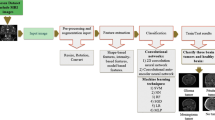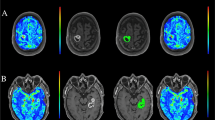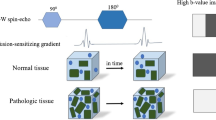Abstract
Purpose
Presurgical functional MRI (fMRI) and diffusion MRI tractography (dMRI tractography) are widely employed to delineate eloquent brain regions and their connections prior to brain tumor resection in adults. However, such studies are harder to perform in children, resulting in suboptimal neurosurgical care in pediatric brain tumor surgery as compared to adults. Thus, our objective was to assess the feasibility and the influence of presurgical advanced MR imaging on neurosurgical care in pediatric brain tumor surgery.
Methods
Retrospective analyses of 31 presurgical fMRI/dMRI tractography studies were performed in children with low-grade tumors near eloquent brain regions at our site between 2005 and 2017.
Results
In only 3/31 cases, imaging results were not interpretable (10%). All 28 successful imaging sessions were used for neurosurgical risk assessment. Based on this, surgery was canceled in 2/28 patients, and intention to treat was changed in 5/28 patients. In 4/28 cases, the surgical approach was changed and in 10/28, electrode placement for intraoperative neurophysiological monitoring was guided by imaging results. Gross total resection (GTR) was planned in 21/28 cases and could be achieved in 15/21 (71%). Despite highly eloquent tumor location, only four children suffered from a mild permanent neurological deficit after the operation.
Conclusions
We demonstrate that presurgical fMRI/dMRI tractography can have a profound impact on pediatric brain tumor management, optimizing preoperative risk-assessment and pre- as well as intraoperative decision-making. We believe that these tools should be offered to children suffering from eloquent brain tumors as part of a comprehensive operative work-up.




Similar content being viewed by others
References
Ottenhausen M, Krieg SM, Meyer B, Ringel F (2015) Functional preoperative and intraoperative mapping and monitoring: increasing safety and efficacy in glioma surgery. Neurosurg Focus 38:E3. https://doi.org/10.3171/2014.10.FOCUS14611
Vlieger EJ, Majoie CB, Leenstra S, Den Heeten GJ (2004) Functional magnetic resonance imaging for neurosurgical planning in neurooncology. Eur Radiol 14:1143–1153
Tieleman A, Deblaere K, Van Roost D, Van Damme O, Achten E (2009) Preoperative fMRI in tumour surgery. Eur Radiol 19:2523–2534. https://doi.org/10.1007/s00330-009-1429-z
Ulmer JL, Salvan CV, Mueller WM, Krouwer HG, Stroe GO, Aralasmak A, Prost RW (2004) The role of diffusion tensor imaging in establishing the proximity of tumor borders to functional brain systems: implications for preoperative risk assessments and postoperative outcomes. Technol Cancer Res Treat 3:567–576
Dimou S, Battisti RA, Hermens DF, Lagopoulos JA (2013) Systematic review of functional magnetic resonance imaging and diffusion tensor imaging modalities used in presurgical planning of brain tumour resection. Neurosurg Rev 36:205–214. https://doi.org/10.1007/s10143-012-0436-8.
Petrella JR, Shah LM, Harris KM, Friedman AH, George TM, Sampson JH, Pekala JS, Voyvodic JT (2006) Preoperative functional MR imaging localization of language and motor areas: effect on therapeutic decision making in patients with potentially resectable brain tumors. Radiology 240:793–802
Haberg A, Kvistad KA, Unsgard G, Haraldseth O (2004) Preoperative blood oxygen level-dependent functional magnetic resonance imaging in patients with primary brain tumors: clinical application and outcome. Neurosurgery 54:902–14-915
Leach JL, Holland SK (2010) Functional MRI in children: clinical and research applications. Pediatr Radiol 40:31–49. https://doi.org/10.1007/s00247-009-1452-x
Wilke M, Holland SK, Myseros JS, Schmithorst VJ, Ball WSJ (2003) Functional magnetic resonance imaging in pediatrics. Neuropediatrics 34:225–233
Byars AW, Holland SK, Strawsburg RH, Bommer W, Dunn RS, Schmithorst VJ, Plante E (2002) Practical aspects of conducting large-scale functional magnetic resonance imaging studies in children. J Child Neurol 17:885–890
Hertz-Pannier L, Chiron C, Vera P, Van de Morteele PF, Kaminska A, Bourgeois M, Hollo A, Ville D, Cieuta C, Dulac O, Brunelle F, LeBihan D (2001) Functional imaging in the work-up of childhood epilepsy. Childs Nerv Syst 17:223–228
Liegeois F, Cross JH, Gadian DG, Connelly A (2006) Role of fMRI in the decision-making process: epilepsy surgery for children. J Magn Reson Imaging 23:933–940
Shurtleff H, Warner W, Poliakov A, Bournival B, Shaw DW, Ishak G, Yang T, Karandikar M, Saneto RP, Browd SR, Ojemann JG (2010) Functional magnetic resonance imaging for presurgical evaluation of very young pediatric patients with epilepsy. J Neurosurg Pediatr 5:500–506
Sievert AJ, Fisher MJ (2009) Pediatric low-grade gliomas. J Child Neurol 24:1397–1408. https://doi.org/10.1177/0883073809342005
Wilke M, Lidzba K, Staudt M, Buchenau K, Grodd W, Krägeloh-Mann I (2005) Comprehensive language mapping in children, using functional magnetic resonance imaging: what’s missing counts. Neuroreport 16:915–919
Wilke M, Lidzba K, Staudt M, Buchenau K, Grodd W, Krägeloh-Mann I (2006) An fMRI task battery for assessing hemispheric language dominance in children. NeuroImage 32:400–410
Mate A, Lidzba K, Hauser TK, Staudt M, Wilke M (2016) A ‘one size fits all’ approach to language fMRI: increasing specificity and applicability by adding a self-paced component. Exp Brain Res 234:673–684. https://doi.org/10.1007/s00221-015-4473-8.
Wilke M (2012) An alternative approach towards assessing and accounting for individual motion in fMRI timeseries. NeuroImage 59:2062–2072. https://doi.org/10.1016/j.neuroimage.2011.10.043
Tournier JD, Calamante F, Connelly A (2007) Robust determination of the fibre orientation distribution in diffusion MRI: non-negativity constrained super-resolved spherical deconvolution. NeuroImage 35:1459–1472
Tournier JD, Calamante F, Connelly A (2012) MRtrix: diffusion dMRI in crossing fiber regions. Int J Imaging Syst Technol 22(1):53–66
Kleiser R, Staempfli P, Valavanis A, Boesiger P, Kollias S (2010) Impact of fMRI-guided advanced DTI fiber tracking techniques on their clinical applications in patients with brain tumors. Neuroradiology 52:37–46. https://doi.org/10.1007/s00234-009-0539-2
Greene DJ, Black KJ, Schlaggar BL (2016) Considerations for MRI study design and implementation in pediatric and clinical populations. Dev Cogn Neurosci 18:101–112. https://doi.org/10.1016/j.dcn.2015.12.005
Amunts K, Malikovic A, Mohlberg H, Schormann T, Zilles K (2000) Brodmann’s areas 17 and 18 brought into stereotaxic space-where and how variable? NeuroImage 11:66–84
Tzourio-Mazoyer N, Josse G, Crivello F, Mazoyer B (2004) Interindividual variability in the hemispheric organization for speech. NeuroImage 21:422–435
Rutten GJM, Ramsey NF, van Rijen PC, Noordmans HJ, van Veelen CWM (2002) Development of a functional magnetic resonance imaging protocol for intraoperative localization of critical temporoparietal language areas. Ann Neurol 51:350–360
Bello L, Gambini A, Castellano A, Carrabba G, Acerbi F, Fava E, Giussani C, Cadioli M, Blasi V, Casarotti A, Papagno C, Gupta AK, Gaini S, Scotti G, Falini A (2008) Motor and language DTI Fiber Tracking combined with intraoperative subcortical mapping for surgical removal of gliomas. NeuroImage 39:369–382
Soares JM, Marques P, Alves V, Sousa N (2013) A hitchhiker’s guide to diffusion tensor imaging. Front Neurosci 7:31. https://doi.org/10.3389/fnins.2013.00031
Solders SK, Carper RA, Muller RA (2017) White matter compromise in autism? Differentiating motion confounds from true differences in diffusion tensor imaging. Autism Res 10:1606–1620. https://doi.org/10.1002/aur.1807
Schreiber A, Hubbe U, Ziyeh S, Hennig J (2000) The influence of gliomas and nonglial space-occupying lesions on blood-oxygen-level-dependent contrast enhancement. AJNR Am J Neuroradiol 21:1055–1063
Bartos R, Jech R, Vymazal J, Petrovicky P, Vachata P, Hejcl A, Zolal A, Sames M (2009) Validity of primary motor area localization with fMRI versus electric cortical stimulation: a comparative study. Acta Neurochir 151:1071–1080. https://doi.org/10.1007/s00701-009-0368-4
Luo Y, Regli L, Bozinov O, Sarnthein J (2015) Clinical utility and limitations of intraoperative monitoring of visual evoked potentials. PLoS One 10:e0120525. https://doi.org/10.1371/journal.pone.0120525
Delion M, Terminassian A, Lehousse T, Aubin G, Malka J, N’Guyen S, Mercier P, Menei P (2015) Specificities of awake craniotomy and brain mapping in children for resection of supratentorial tumors in the language area. World Neurosurg 84:1645–1652. https://doi.org/10.1016/j.wneu.2015.06.073
Liu Z, Berrocal VJ, Bartsch AJ, Johnson TD (2016) Operative fMRI data analysis using a spatially adaptive conditionally autoregressive model. Bayesian Anal 11:599–625
Farquharson S, Tournier JD, Calamante F, Fabinyi G, Schneider-Kolsky M, Jackson GD, Connelly A (2013) White matter fiber dMRI: why we need to move beyond DTI. J Neurosurg 118:1367–1377. https://doi.org/10.3171/2013.2.JNS121294
Kupper H, Groeschel S, Alber M, Klose U, Schuhmann MU, Wilke M (2015) Comparison of different dMRI algorithms and validation by intraoperative stimulation in a child with a brain tumor. Neuropediatrics 46:72–75. https://doi.org/10.1055/s-0034-1395346.
Toselli B, Tortora D, Severino M, Arnulfo G, Canessa A, Morana G, Rossi A, Fato MM (2017) Improvement of white matter tract reconstruction with constrained spherical deconvolution and track-density mapping in low angular resolution data: a pediatric study and literature review. Front Pediatr 5:182. https://doi.org/10.3389/fped.2017.00182
Brown TT, Lugar HM, Coalson RS, Miezin FM, Petersen SE, Schlaggar BL (2005) Developmental changes in human cerebral functional organization for word generation. Cereb Cortex 15:275–290
Gaillard WD, Balsamo L, Xu B, McKinney C, Papero PH, Weinstein S, Conry J, Pearl PL, Sachs B, Sato S, Vezina LG, Frattali C, Theodore WH (2004) fMRI language task panel improves determination of language dominance. Neurology 63:1403–1408
Benjamin CF, Walshaw PD, Hale K, Gaillard WD, Baxter LC, Berl MM, Polczynska M, Noble S, Alkawadri R, Hirsch LJ, Constable RT, Bookheimer SY (2017) Presurgical language fMRI: mapping of six critical regions. Hum Brain Mapp 38:4239–4255. https://doi.org/10.1002/hbm.23661
Duncan JS (2010) Imaging in the surgical treatment of epilepsy. Nat Rev Neurol 6:537–550. https://doi.org/10.1038/nrneurol.2010.131
Funding
This study was funded in part by the H.W. & J. Hector Foundation, Mannheim, Germany (M66). The sponsor had no part in study design, interpretation of results, or decision to publish.
Author information
Authors and Affiliations
Corresponding author
Ethics declarations
Conflict of interest
None of the authors has any conflict of interest to disclose.
Ethical approval
All procedures performed were in accordance with the ethical standards of the institutional and/or national research committee and with the 1964 Helsinki declaration and its later amendments or comparable ethical standards.
Informed consent
All caregivers provided informed consent.
Rights and permissions
About this article
Cite this article
Lorenzen, A., Groeschel, S., Ernemann, U. et al. Role of presurgical functional MRI and diffusion MR tractography in pediatric low-grade brain tumor surgery: a single-center study. Childs Nerv Syst 34, 2241–2248 (2018). https://doi.org/10.1007/s00381-018-3828-4
Received:
Accepted:
Published:
Issue Date:
DOI: https://doi.org/10.1007/s00381-018-3828-4




